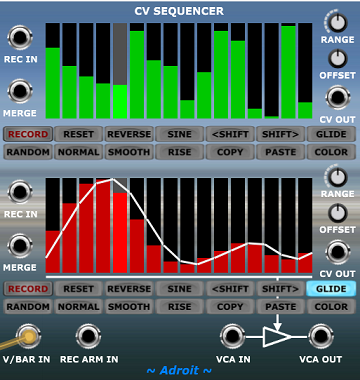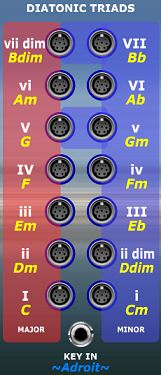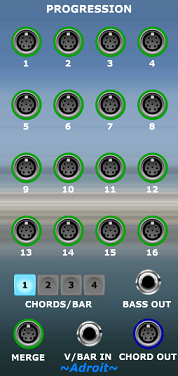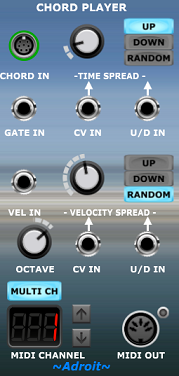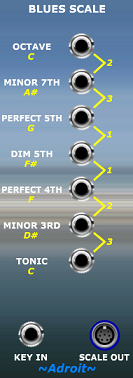
LSSP 101 is a carefully selected subset of LSSP XL designed to give you an introduction to the Adroit Synthesis Large Scale Sequencing Project.
LSSP 101 comes with a series of tutorials that introduce you to LSSP concepts such as V/Bar sequencing, Time Splitting and S-Poly based chords and scales.
Each tutorial includes a .voltagepreset files so you can be exploring basic examples of what LSSP 101 is capable of almost immediately (assuming that you have Voltage Modular already installed).
Note that LSSP 101 is only available for Cherry Audio’s Voltage Modular.
Table of Contents
Song Control and Song Part
These modules work together to form something called the Song Control Sequencer. Although it is technically possible to build LSSP patches that do not use the Song Control Sequencer, this is the best place to start to understand LSSP and V/Bar sequencing.
CV Sequencer
Apart from being controlled by a V/Bar signal rather than a clock and having some other unusual features, CV Sequencer’s functionality is something that most people will quickly feel at home with as it’s a two-channel 16 step sequencer that produces standard control voltages that you can plug into your regular patches and get up and running with straight away.
LSSP 101 Tutorial 1 explores using Song Control, Song Part and CV Sequencer to create a simple first patch.
Rhythm Sequencer
This module is quite complex, however at its core there’s an old-fashioned “X0X” style rhythm generator that produces gate and velocity signals so it should soon start to feel pretty familiar.
LSSP 101 Tutorial 2 expands on the first tutorial and introduces the Rhythm Sequencer.
Diatonic Triads
This module provides the essential three note chords used in millions of songs. Extended chords and inversions are only available in LSSP XL but this module is an excellent place to start exploring harmony.
Progression
This module is a specialised sequencer that allows you to program chord progressions by patching S-Poly chord signals such as those provided by the Diatonics Triad module into its input sockets.
Chord Player
This module takes S-Poly chord signals along with regular gate and velocity inputs and converts them into polyphonic MIDI messages making it very easy to create things like rhythmical chord stabs, pads, strumming accompaniments etc.
Pitch Adjuster
This module provides a pair of pitch quantizers that adjust pitch control voltages so that they fit in with the chord or scale currently being fed to it via an S-Poly signal.
Using quantization isn’t as powerful a technique as using the Melody Sequencer (which is only available in LSSP XL) but it integrates well with non-Adroit modules and enables you to use CV Sequencers to sequence coherent pitches and use things like envelope generators and LFOs to generate arpeggios.
Blues Scale
The Blues Scale module is included as an example of an Adroit scale module. It’s not a comprehensive tool as it represents just one scale of many but it demonstrates the concept. LSSP XL features other scale modules and it’s relatively easy to create custom scales using LSSP XL facilities.
The blues scale was chosen as an example because it just sounds cool! Whack almost any varying control voltage into a Pitch Adjuster fed with the Blues Scale S-Poly scale signal and you might be pleasantly surprised at how musical the result can be.
Time Split 2 and Time Split 4
You can use just Song Part modules to construct multi-bar phrases one bar at a time but it’s rather overkill. Song Parts are really intended to sequence whole segments of a song such as a chorus or verse rather than individual bars (although there’s nothing to stop a song part being just a single bar in length).
Time Splitter modules provide you with an extra intermediate level of sequencing that can bridge the gap between song parts and single bar sequences and open up the possibility of constructing musical forms such as AAAB, ABAC and so on (where A, B and C are single bar sequences).
The simplest Time Splitters are Time Split 2 and Time Split 4.
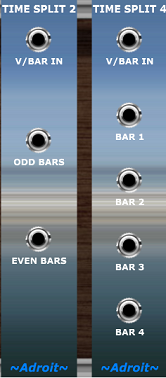
Time Split Fills
This module is another time splitter. It makes it easy to create fills – single bar variations at the end of 4, 8, 12 or 16 bar long phrases.
Sample & Hold
This simple module is helpful in some patches to keep a pitch steady during sustained notes. It performs just a subset of the work that the Cherry Audio Sample and Hold module does but is provided because it’s easier to use in most applications.

Ad Astra
While LSSP 101 is a powerful bundle of modules in its own right, once you have worked through the tutorials, played with it for a while and the concepts involved in LSSP become familiar friends; you will discover that you want to achieve more and that the extra functionality you are seeking is (mostly) provided by all those extra LSSP XL modules that initially looked kind of pointless!

